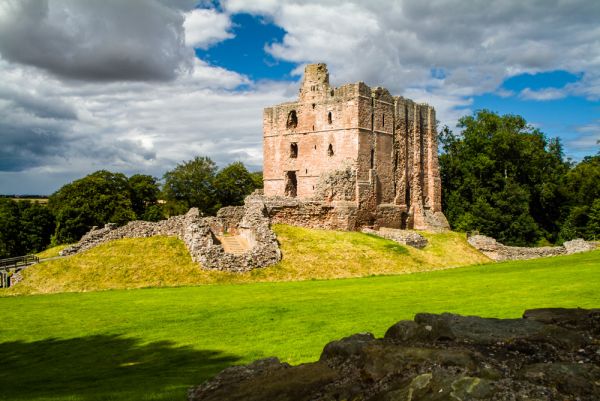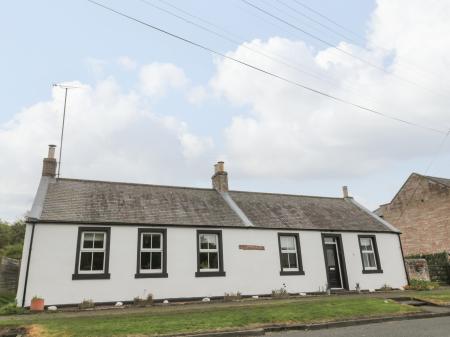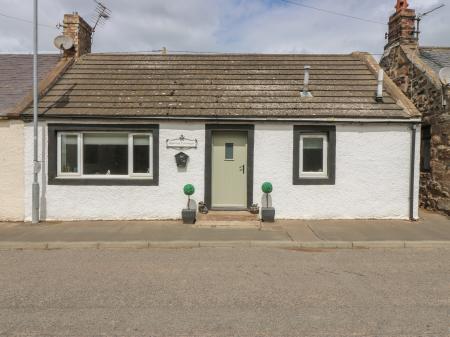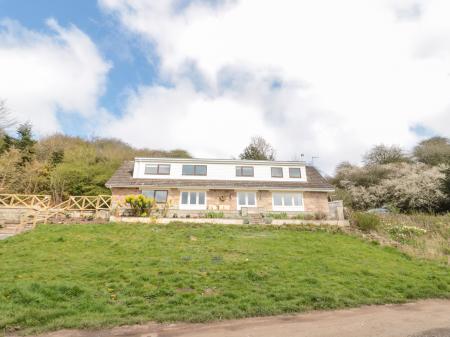
Norham Castle is an imposing Norman fortress built on the banks of the River Tweed around 1121 by Ranulf Flambard, the powerful Bishop of Durham. The castle stands on the site of a much earlier prehistoric fort. The Bishop's fortress was rudimentary; little more than an earthen ringwork with a timber palisade around a ceremonial hall. It was meant primarily to protect the Bishop's estates in the region.
Norham was part of a defensive string of castle guarding the Tweed crossings between England and Scotland, along with the castles at Wark and Berwick.
In AD 1153 Henry II ordered Hugh de Puiset, the serving Bishop of Durham, to rebuild Norham. This the bishop did on a grand scale, sparing no expense in creating a fortress that was at the same time a castle and a grand residence. Bishop Puiset replaced the earlier two-storey hall with a great tower, providing luxurious accommodation at the heart of a complex of buildings within an encircling wall.
King John extended De Puiset's work between 1208 and 1212 and strengthened the defences. It was just as well that he did, for in 1215 Alexander II of Scotland laid siege to Norham. The siege lasted 40 days, but the defenders held firm. A peace treaty between England and Scotland was signed at Norham in 1219.
Six decades later in 1291 Edward I stayed at Norham as a guest of Bishop Anthony Beck while he acted as arbiter in the 'Great Cause', choosing the best-qualified claimant to the throne of Scotland. The final decision in favour of John Baliol was actually made at Berwick Castle in 1292, but Baliol paid his feudal homage to Edward in the great hall at Norham just a few days later.
Their accord was short-lived, and Edward I subsequently claimed the throne of Scotland himself. This launched a prolonged period of border warfare. The Scots unsuccessfully attacked Norham in 1318, 1319, and 1322. They finally succeeded in capturing Norham in 1327 but almost immediately handed it back to the Bishop of Durham.
In 1497 James IV of Scotland attacked Norham as part of his support for Perkin Warbeck's rather suspect claim to the English throne. The Scots bombarded the castle with artillery, including the famous Mons Meg, the huge siege gun now on display at Edinburgh Castle. The castle held out for two weeks before an English army arrived to force the Scots into retreat.

Norham was the most powerful castle in the north of England, and as a result, it suffered Scottish sieges on more than a dozen occasions. It withstood all except the last; in 1513 James IV battered Norham into submission with his artillery. But though Norham was captured, the Scots could not hold it, for just 3 weeks later James was defeated at the Battle of Flodden and the castle was restored to the Bishop of Durham once more.
The castle had been so badly damaged by the Scottish bombardment that it required a massive rebuilding effort. The medieval fortress was transformed into a fortress strong enough to withstand the new threat of artillery. Military engineers created covered gunnery platforms and strengthened the base of the castle walls with earth to absorb cannon shot.
The castle was seized by the English crown in 1559 when the Bishop of Durham refused to take the Oath of Supremacy acknowledging the monarch as head of the church.
The castle was garrisoned for most of the 16th century, but in 1596 Elizabeth I refused to spend any more money on the decaying structure. After the union of the English and Scottish crowns in 1603, the castle was deemed unnecessary and was allowed to decay.
The castle stands on a grassy hillock, offering a commanding view of the River Tweed below.
The most impressive part of Norham is the strong, square, central keep, known as the Great Tower, restored in the 16th century. The north face of the Great Tower has completely collapsed, probably because this part of the keep bore the brunt of the 1513 bombardment and was not repaired to the same standard as the south part of the building.
There are two wards; an outer ward which leads over a moated drawbridge to the inner ward. In the inner ward are the remains of a bishop's hall and the imposing keep. Below the keep are later artillery emplacements overlooking the River Tweed.






 We've 'tagged' this attraction information to help you find related historic attractions and learn more about major time periods mentioned.
We've 'tagged' this attraction information to help you find related historic attractions and learn more about major time periods mentioned.


